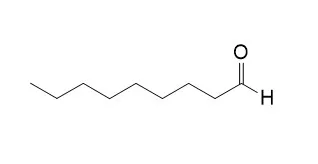| In vitro: |
| Journal of Applied Entomology, 2010, 128(9-10):639-644. | | Evaluation of semiochemicals potentially synergistic to α-pinene for trapping the larger European pine shoot beetle, Tomicus piniperda (Col., Scolytidae).[Reference: WebLink] | The pine shoot beetle, Tomicus piniperda (L.) (Col., Scolytidae) is an exotic pest of pine, Pinus spp., in North America. It is attracted strongly to host volatiles (±)-α-pinene, (+)-3-carene, and α-terpinolene. Attraction to insect-produced compounds is less clear. Other potential attractants include trans-verbenol, myrtenol, myrtenal, Nonanal and α-pinene oxide.
METHODS AND RESULTS:
We conducted a series of field experiments to determine if any of these compounds would increase attraction of T. piniperda to α-pinene, either individually or in various combinations.
CONCLUSIONS:
None of the individual compounds increased attraction. Although several combinations that included trans-verbenol, Nonanal, myrtenol, or myrtenal increased attraction, results were variable between experiments. | | Journal of Chemical Ecology, 2008, 34(9):1180-1189. | | Identification and field evaluation of grape shoot volatiles attractive to female grape berry moth (Paralobesia viteana).[Pubmed: 18649104] |
METHODS AND RESULTS:
Solid-phase microextraction (SPME) and gas chromatography coupled with electroantennographic detection (GC-EAD) were used to identify volatile compounds from shoots of riverbank grape (Vitis riparia) that attract the female grape berry moth (GBM, Paralobesia viteana). Consistent EAD activity was obtained for 11 chemicals: (Z)-3-hexen-1-yl acetate, (E)-linalool oxide, (Z)-linalool oxide, Nonanal, linalool, (E)-4,8-dimethyl-1,3,7-nonatriene, methyl salicylate, decanal, beta-caryophyllene, germacrene-D, and alpha-farnesene. In flight-tunnel tests that involved female GBM and rubber septa loaded with subsets of these 11 compounds, we found that both the 11-component blend and a seven-component blend, composed of (E)-linalool oxide, (Z)-linalool oxide, Nonanal, (E)-4,8-dimethyl-1,3,7-nonatriene, decanal, beta-caryophyllene and germacrene-D, elicited equivalent levels of upwind flight as freshly cut grape shoots.
The removal of any of the seven compounds from the seven-component blend resulted in a significant decrease in female upwind flight responses.
CONCLUSIONS:
In a field trial with these two synthetic blends, traps equipped with either blend captured more female GBM compared to traps baited with hexane only (control), although the number of females caught was generally low. There were no differences in the number of males captured among treatments. Although in flight-tunnel trials, moths readily flew upwind to both grape shoots and rubber septa loaded with the best lures, they landed on shoots but not on rubber septa. Coupled with relatively low field catches, this suggests that additional host finding cues need to be identified to improve trap efficacy. |
|






 Cell. 2018 Jan 11;172(1-2):249-261.e12. doi: 10.1016/j.cell.2017.12.019.IF=36.216(2019)
Cell. 2018 Jan 11;172(1-2):249-261.e12. doi: 10.1016/j.cell.2017.12.019.IF=36.216(2019) Cell Metab. 2020 Mar 3;31(3):534-548.e5. doi: 10.1016/j.cmet.2020.01.002.IF=22.415(2019)
Cell Metab. 2020 Mar 3;31(3):534-548.e5. doi: 10.1016/j.cmet.2020.01.002.IF=22.415(2019) Mol Cell. 2017 Nov 16;68(4):673-685.e6. doi: 10.1016/j.molcel.2017.10.022.IF=14.548(2019)
Mol Cell. 2017 Nov 16;68(4):673-685.e6. doi: 10.1016/j.molcel.2017.10.022.IF=14.548(2019)